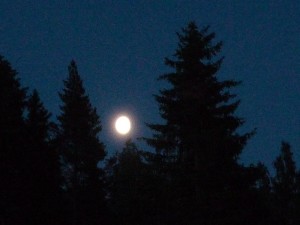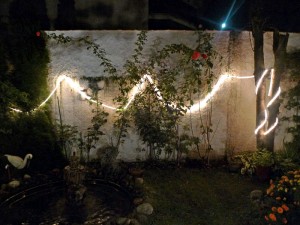The Seventh Day

The Finnish national Epos Kalevala tells us that in the beginning of the world all things came into existence with a duck’s egg. Let us now imagine this egg. It is just like the Seventh Datscha-Radio day: Full of surprises, events, music and never-heard-of-things. Among our famous guests were sound artist Klaas Hübner with his experimental Oscillator Fruit Salad, Morgenvogel Radio with Maria Leena Räihälä and Manuel Bonik, a group of talented youngsters who termed their instant-Datscha-band “Bermünch”, Carola Haupt and Julia from the Italian Radio Papesse, … to name just a few of them. And our edtior and great radio show maker Verena Kuni left us to return to Frankfurt. Sigh! Wonderful work and a great time we had with you, Verena!
Meanwhile, we found the time to upload our pictures, so let us take another look at the Datscha-world-egg of the 30th of August:
Evidently the self built oscillator fruits were tasty and did not electrify the ladies savouring them (at least not in any negative sense). Verena Kuni led through the experimental set-up and evolved even more energetic than before. Arrival of the Munich twins Lena and Lulu and Marie Schwab with her guitar. The girls played “This is what we would like to hear in the radio but they don’t play those songs”, Marie sang (a. o. ) a John Lee Hooker, and Lena turned out to be such a talented radio host that I could steal away from their show and join the conversations outside. The girls were joined by their friends Carl (ukulele) and Julian (guitar), both members of the Berlin band “infinity repeat”.
Morgenvogel Radio’s show featured the artist Michael (surname will be added) as performing guest and presented a surrealist blend of live performance, interview, talk on bird houses, musical interventions and readings from the Kalevala. Manuel Bonik’s laptop was wired to the boombox – analogue mixing without a mixer! –, the micro was wired to our spontaneous brain waves, a black egg served as another musical medium, a ladder was placed next to the cherry tree and Datscha-Radio got presented with an original Morgenvogel bird house – manufactured by the tender hands of Maria Räihälä herself. Thank you! More bird houses are still available from Morgenvogel Real Estate: The aim is to establish more homes for birds (and you don’t need to own a garden for that!): Be it your window sill, roof top or balkony, your favorite tree in the park, etc. Only traffic lights won’t work since they usually lack the leafy, green environment needed for a bird’s natural habitat.
In the meantime, the artist KH Jeron showed up, again in his seemingly favourite disguise as a cooking magician. This time he conjured a very delicious apple crumble pie for us of us. Thank you!
Around 10 pm Hannes Wienert arrived straight from Hamburg, wearing with a toupee and carrying his suitcase full of his peculiar collection of Asian and not-so-Asian instruments into our datscha. Morgenvogel Radio had gone slightly huppelissa, tangos were played and the full moon was up in a misty sky.
This is how the “Moon Hour” started. Manuel Bonik moved his laptop to the studio, Hannes played improvisations on this Chinese mouth organ – the infamous sheng – and as far as I remember Maria and I sang a karaoke version of Blue Moon… or did we?
Yes, and after a mind-bending free gallop over the nightly fields of more loony moony tunes, the reading of Finnish poems and more tango, there came the sad and terrible moment to say Goodbye to Verena Kuni, our brilliant co-editor from radia.fm. A treasure of knowledge and practical thought she is! Again great thanks to you, without your help a great part of our program would have never been realized!
Read More














































